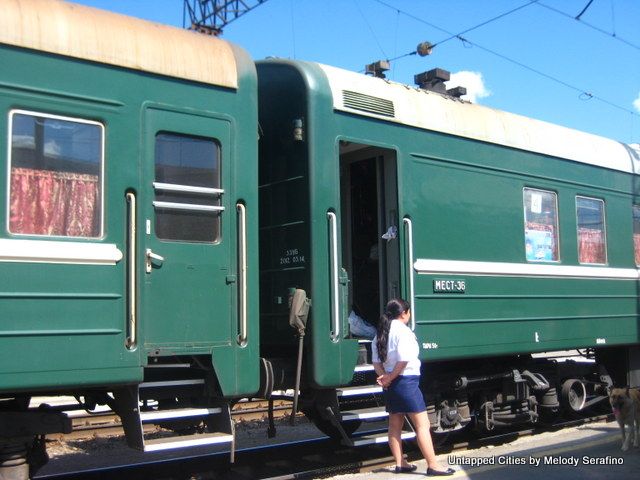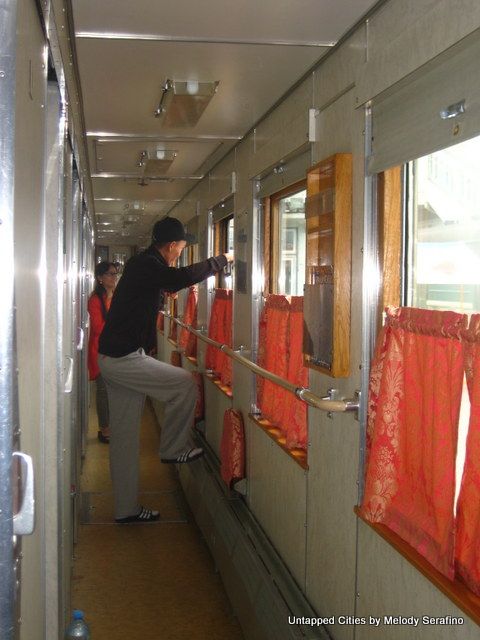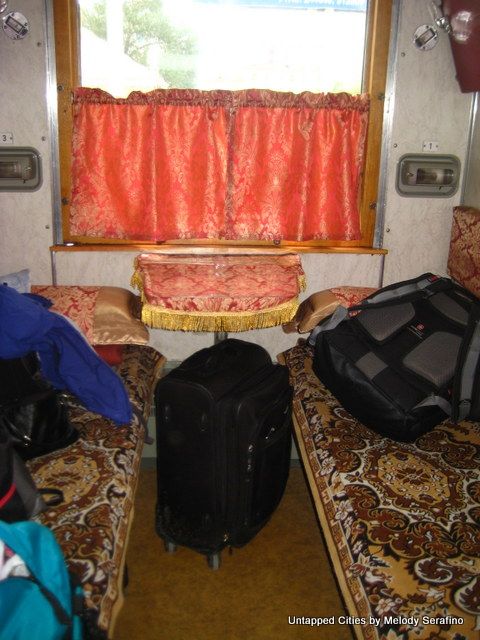Last Chance to Catch NYC's Holiday Notalgia Train
We met the voices of the NYC subway on our nostalgia ride this weekend!


 Waiting to board the Trans-Siberian Railway at a stop in rural Russia.
Waiting to board the Trans-Siberian Railway at a stop in rural Russia.
Riding the Trans-Siberian Railway is one of those trips that elicits two distinct responses from friends and family. The first, often from those whose only understanding of the famed Eurasian railway is the 2008 murder mystery film, “Transsiberia,” is a look of utter perplexity followed by something that translates roughly to, “I’m trying to be supportive of this, but why would you do such a dangerous and crazy thing, and by the way please don’t get [insert negative verb here, typically: kidnapped, killed, etc.].” The second comes from the more adventure-minded who immediately get excited, and then the inevitable game of 20 Questions ensues.
Last month I had the privilege of joining two friends on the Trans-Siberian Railway from Beijing to Ulaan Bataar (the capital of Mongolia) to Moscow. For someone who plans travel itineraries in her sleep, deciding to hop aboard the longest railway in the world just one month before departure was admittedly very last-minute for me. In between securing my Russian and Chinese visas, I began researching exactly what I was getting myself into, starting with the most obvious resource – the Trans-Siberian Railway ticket website. The only problem: it offers very little information about what to expect. No FAQ section, traveler testimonials or suggested checklist of items to pack. Though I was able to dig up a few blog posts from past travelers, I vowed to keep a detailed journal and share my own tips upon my return.
For those who are considering embarking on this incredible journey or are just curious to hear how one survives it, here are my top ten tips for conquering the incredible Trans-Siberian Railway:
1. Do not underestimate the power of the baby wipe. As a child I was embarrassed by my mother’s germ-phobic tendency to pull out a packet of “Wet Ones” whenever we were out to eat at a restaurant. Mom, on this trip you would’ve been proud. Wipes are multipurpose on the Trans-Siberian Railway: they clean urine-splattered toilet seats before use, replace water and soap when bathroom doors are locked shut while at station stops and freshen you up when showers aren’t an option.
2. Bring lots of snacks, particularly if you have dietary restrictions. As a pescatarian, I am always thinking about my food options when I travel. Train food can be pricey, and though food kiosks are typically available at every station, biscuits and noodle bowls quickly become tasteless. Ample hot water is provided in each train car to make coffee, tea and soups, but packing a trusty stash of granola bars, pretzels, dried fruit and other non-perishables not only helps supplement meals but also serves as a good stash for on-board bartering with other travelers.
 The Mongolian dining car: the interior changed depending upon the country in which we were traveling.
The Mongolian dining car: the interior changed depending upon the country in which we were traveling.
3. Document your experience. Just because you don’t fancy yourself the next Henry David Thoreau shouldn’t preclude you from taking along a journal in which to reflect or note-take – it may just be your most valuable souvenir. The train is a great way to meet people from around the world, and being able to remember those moments on paper is priceless. Having a pen and paper also allows for mid-afternoon games of Hangman and composing late-night bucket lists.
 A room with a view: admiring the countryside from the shared train hallway.
A room with a view: admiring the countryside from the shared train hallway.
4. Pick up a Russian phrase book. The Russian alphabet is tricky for non-Slavic language speakers, but learning to recognize certain letters and understanding key words and phrases is useful. Most train attendants speak very limited English. Spasiba (that’s “thank you” for all you non-Russian speakers).
5. Stick close to the train at station stops. Most stops don’t exceed 20 minutes and the temptation to wander off into rural Russia after being cooped up in a tiny train car can be overwhelming, but the train waits for no one. Departure announcements, if made, are in Russian and there won’t be a whistle to signify it’s time to go. Not much warning is given before the train leaves the station and getting left behind could delay your travels for days.
 An unidentified building near one of the train stops in Russia.
An unidentified building near one of the train stops in Russia.
6. Get to know your fellow passengers. You’re all in this together and being social will not only open you up to more experiences, but travelers will be more apt to help you out along the way. The train is full of interesting international explorers – and let’s face it – you’ve got some conversation time to kill.
7. Stay on a normal sleep schedule. The first day I felt continually lulled to sleep by the motion of the train, but I also never felt fully rested even when I’d napped for hours. Once you cross the border into Russia, the train runs on Moscow time. Keeping a regular sleep schedule will help you to feel refreshed. Plus, being awake during daylight hours allows you to take in the spectacular views of the countryside. When else will you ever see Russia in this way?
 Mongolian sunset as seen from the train window.
Mongolian sunset as seen from the train window.
8. Pack light but layered. Train cabins are cramped, and lugging around a heavy roller suitcase is exhausting and annoying. Everyone recycles outfits on the train. This is definitely not a trip for the fashion conscious. Remember, if you’re not in a first class cabin you won’t even have a shower. Be sure to bring light layers, even in the summer. Temperatures change quickly and unexpectedly and the only air conditioning is in the dining car.
 Even small suitcases take up a lot of space in the train cabin’s tight quarters.
Even small suitcases take up a lot of space in the train cabin’s tight quarters.
9. Make it a point to get dressed every day. It seems obvious, but it’s easy to get lazy and lounge in pajamas or sleep in your day clothes. Switching it up will make you feel clean even when you’re four days in without a shower. Also, baby powder does wonders for unwashed, greasy hair.
10. Take along a small plastic cup or thermos (or pick one up at the store at the Mongolian border for the equivalent of one American dollar) that can be rinsed and reused for tea and coffee. Plastic silverware is also a must for food that doesn’t come equipped for eating.
Subscribe to our newsletter